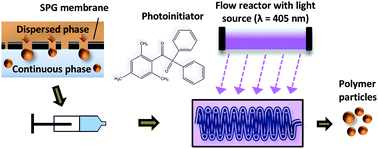Miniemulsion photopolymerization in a continuous tubular reactor: particle size control via membrane emulsification†
Abstract
Synthesis of polymeric nanoparticles of adjustable size in the submicron-range 200–950 nm has been conducted via membrane emulsification combined with photoinduced miniemulsion polymerization in a continuous tubular flow reactor. Monomer droplets comprising methyl methacrylate (MMA), hexadecane and the photoinitiator diphenyl(2,4,6-trimethylbenzoyl)phosphine oxide were prepared as an aqueous emulsion with the surfactant sodium dodecyl sulfate (SDS) using fixed membrane pore sizes of 100, 200, 300 and 400 nm. Radical polymerizations were subsequently conducted by exposure of these emulsions to visible (violet) irradiation (λmax = 405 nm) at room temperature in a continuous tubular flow reactor for polymerization times (residence times) as short as 10 min. Careful consideration of the SDS concentration as well as the use of an aqueous phase radical scavenger enabled design of systems providing exclusive monomer droplet nucleation (in the absence of secondary nucleation). In contrast to conventional emulsification techniques, membrane emulsification provides an energy efficient method for tuning the polymer particle size from submicron to micron range by appropriate selection of pore size.

- This article is part of the themed collection: Polymer Chemistry Lectureship Winners


 Please wait while we load your content...
Please wait while we load your content...